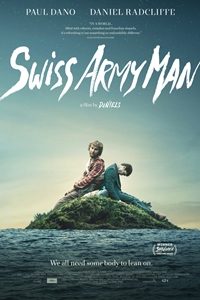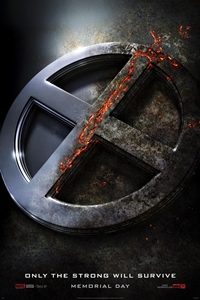 Hunt for the Wilderpeople
Hunt for the Wilderpeople
Starring Julian Dennison, Rachel House, Sam Neill, and Rima Te Wiata
Directed by Taika Waititi
Rated PG-13
Run Time: 101 minutes
Genre: Comedy/Drama
Opens July 8th
By Eric Forthun of Cinematic Shadows
Hunt for the Wilderpeople is a pleasant comedy propelled almost exclusively by dry, character-driven humor. That's a refreshing characteristic in a summer landscape bloated with contrived, action-heavy blockbusters and gross-out comedies led by men and women alike. Writer-director Taika Waititi is a creative force that will be increasingly nitpicked, considering his next film is Marvel's Thor: Ragnarok; independent filmmaking terms will be applied to his work in order to pinpoint how exactly his films can function across all budgets and scopes. Quite simply, he crafts stories around characters and understands their vitality in making a narrative work. While Hunt for the Wilderpeople is a bit too light and skippy to be a truly affecting and essential piece of filmmaking, it still presents an unique and often dry-as-a-corkboard funny vision of two lost souls after tragedies strike them.
The film follows Ricky (Julian Dennison), a child that has flown between foster families often into his teenage years. He is labelled as troublesome, violent, and mischievous, with increasingly stretched reasoning provided by Paula (Rachel House), the social worker in charge of him. He is placed in the care of Aunt Bella (Rima Te Wiata) and Uncle Hector (Sam Neill), a couple living in the hills of New Zealand. Aunt Bella, as the audience learns, is probably the first person to ever show Ricky genuine care and hospitality. He changes in demeanor, begins behaving responsibly, and takes initiative; it's amazing what proper parenting can accomplish. Yet circumstances arise where Ricky and Uncle Hec are paired together and forced to travel through the wild New Zealand bush alongside their dog companion and the other animals inhabiting the forests. A national manhunt begins to find Ricky and bring him back to the foster service, after which he will probably be jettisoned to juvenile detention.
Comedy functions in numerous ways: as observation, as tonal shifts, and often times as a form of tragedy. Waititi's vision relies almost exclusively on tonal shifts, varying widely from character drama to action backed by a percussion-heavy soundtrack to slapstick comedy. These shifts often happen within the same scene to surprisingly strong effect. They not only place the audience on its feet in terms of expectation, but also allow the audience to move through the character's insights and actions while discovering their own approach. The most impactful element of the film is Dennison's committed performance; it's often difficult to distinguish proper acting within a young newcomer, but his comedic timing is undeniably top-notch. His thick accent further helps the dryness of the material. Some audiences will find the humor off-putting or simply not funny, particularly since dry jokes often bring together or isolate audience members. Hunt for the Wilderpeople should do the former and allow for an easy connection with these characters; if it doesn't, at least there is a wonderful appearance by an unforgettable character named Psycho Sam. Waititi is a talented director, and the acting here is strong, particularly from Dennison and Neill. Their chemistry produces some truly affecting scenes, even as the film relies on conventions to move its narrative forward. Hunt for the Wilderpeople is still a delightful romp.

 ‘Wiener-Dog’ sometimes barks up the right tree
‘Wiener-Dog’ sometimes barks up the right tree
 The Secret Life of Pets
The Secret Life of Pets
 The Purge: Election Year
The Purge: Election Year
 ‘Swiss Army Man’ uses many gadgets but does not connect
‘Swiss Army Man’ uses many gadgets but does not connect
 Tarzan swings…and misses
Tarzan swings…and misses
 Big, Friendly, but not so giant a hit
The BFG is entertaining but not memorable
Big, Friendly, but not so giant a hit
The BFG is entertaining but not memorable The Neon Demon
The Neon Demon
 ‘The Shallows’ works until the script drowns in the last act
‘The Shallows’ works until the script drowns in the last act
 ‘The Music of Strangers’ hits some high notes
‘The Music of Strangers’ hits some high notes
 Finding Dory
Finding Dory
 Memorable performances make ‘Genius’ a smart choice
Memorable performances make ‘Genius’ a smart choice
 The Conjuring 2
The Conjuring 2
 ‘Now You See Me 2’ conjures too much silliness to believe its magic
‘Now You See Me 2’ conjures too much silliness to believe its magic
 Despite impressive visuals, ‘Warcraft’ loses its way
Despite impressive visuals, ‘Warcraft’ loses its way
 Clarke’s bright star turn lights up ‘Me Before You’
Clarke’s bright star turn lights up ‘Me Before You’
 ‘Weiner’ unbelievably captures a disastrous political train wreck
‘Weiner’ unbelievably captures a disastrous political train wreck
 Make casual plans to check out ‘Maggie’s Plan’
Make casual plans to check out ‘Maggie’s Plan’
 X-Men: Apocalypse
X-Men: Apocalypse








